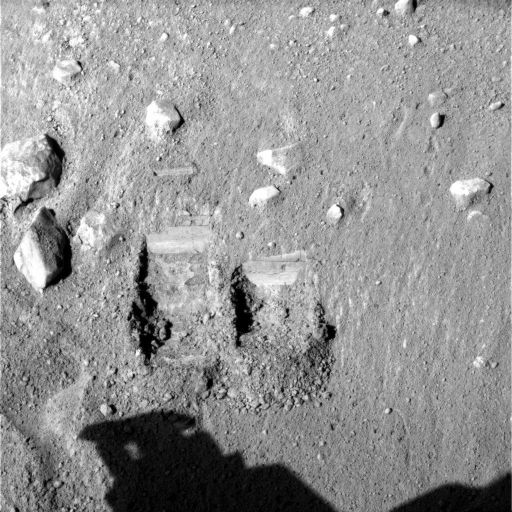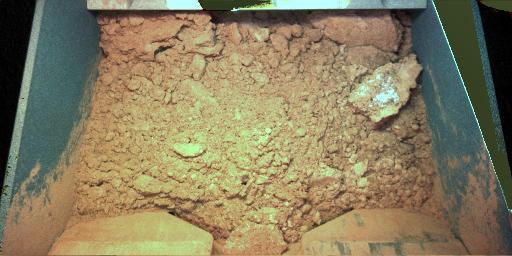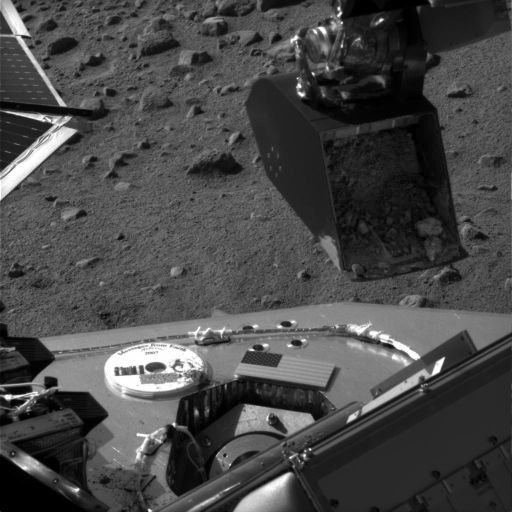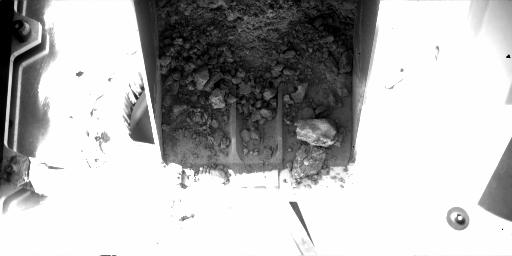Emily Lakdawalla • Jun 06, 2008
Phoenix sol 11: A dig at Baby Bear; poised to dump first TEGA sample
Phoenix made the all-important first grab for a sample of soil yesterday, sol 11, at a site named "Baby Bear." This dig wasn't really any different from the first dig it made at Dodo -- the trench seems to be about the same size -- but this time, they didn't dump out the scoop; they tilted the scoop upward to let the sample slide into the back, and then rotated the arm to position it over TEGA. And that's where Phoenix left things yesterday. Here's the three press-released images today, which ably document the activity. First, the new trench site:

NASA / JPL / SSI / UA
Dodo and Baby Bear trenches, Phoenix sol 11
The trench on the left is named "Dodo" (for the character in Alice in Wonderland, the site of Phoenix' first two dig-and-dump tests on sols 7 and 9. Next to it is "Baby Bear," dug on sol 11 in order to collect the first sample for the TEGA instrument. The same trench will be used to acquire a sample for the optical microscope, and then a new trench at a site named Mama Bear, immediately to the right, will be dug to acquire a sample for the we chemistry laboratory.
NASA / JPL / UA / MPI
Phoenix' first scientific sample of soil
After digging up a sample at Baby Bear on sol 11, Phoenix shot a photo of the interior of the scoop with its robotic arm camera. Note the large clod of soil to the right, which appears to be white under a coating of dirt. For scale, the whole scoop has a width of 8.5 centimeters (about 3.5 inches).
NASA / JPL / UA
Phoenix' first soil sample poised over TEGA
On sol 11, Phoenix gathered its first scoopful of soil from the Martian surface and brought it over the TEGA instrument. One set of TEGA's doors is open and waiting to receive the sample. Note the large clod of soil at the right edge of the scoop; in closeup views from the Robotic Arm camera, this clod had whitish features. TEGA's ovens are protected with a one-millimeter mesh, allowing only smaller soil particles to enter. After the scoopful of soil has been dumped onto TEGA, the hopper inside will vibrate, shaking soil bits down into a sample oven about two millimeters wide by three centimeters long.So now the plan is to deliver the sample to TEGA tosol, and then wait for verification from TEGA that the sample was collected successfully. Over the next few sols, they'll grab a second sample from the same Baby Bear site, a much smaller one this time, and deliver it to a fresh Optical Microscope slide. Then they'll go next to Mama Bear to grab a sample for the wet chemistry lab. This is all an arduously slow process. Dig, photo the scoop, move the scoop over the instrument -- that's one sol. Deliver the sample, and check the scoop to make sure it's empty, and find out if the instrument is happy with its sample -- that's another sol. Start up the analysis -- that's a third sol. For TEGA at least, the analysis then takes a minimum of four sols, and probably more. One complete sampling cycle, delivering samples to all three instruments, is supposed to take eight sols; it might be more if there are anomalies, and less if they don't use all the instruments. (There are eight TEGA ovens but only four wet chemistry cells.)
That's about it for today. I do want to announce that, with a lot of help from Michael Howard, the author of the fabulous Midnight Mars Browser software, I'm now producing my own set of browse pages for the Phoenix raw image data, sorted by sol, and delivered with a lot of "metadata" describing the timing, pointing, filter choices, and other facts for each of the images. I hope people find these pages useful! Today, in addition to the photos I posted above, they also downlinked a massive quantity of data from Sol 10, the "runout" sol. It was much more productive than the first runout sol, sol 2 -- looks like the Phoenix team has been hard at work building extra sequences to take full advantage of the occasional communications problem.


 Explore Worlds
Explore Worlds Find Life
Find Life Defend Earth
Defend Earth


